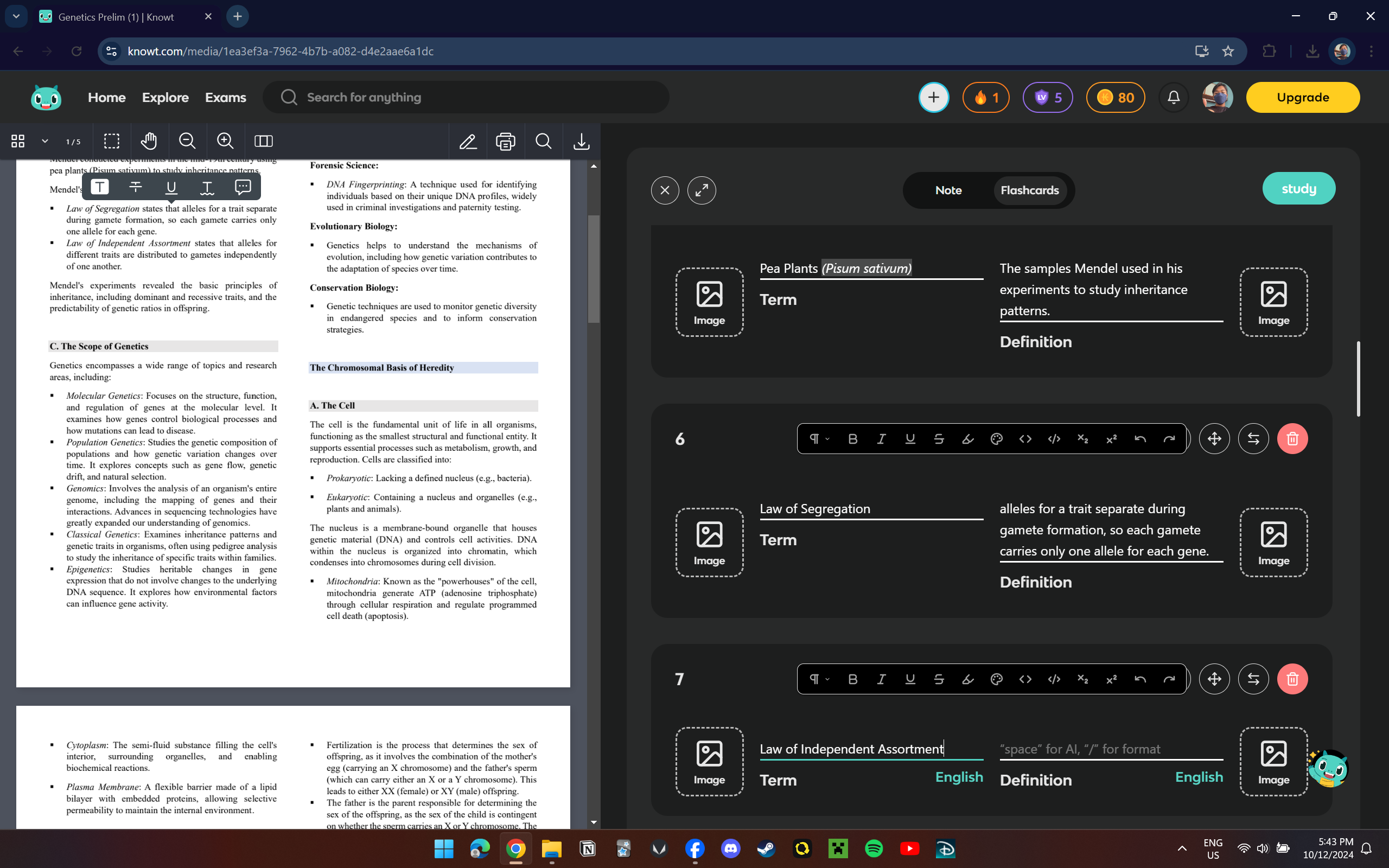Genetics Prelim (1)
1/37
There's no tags or description
Looks like no tags are added yet.
Name | Mastery | Learn | Test | Matching | Spaced |
|---|
No study sessions yet.
38 Terms
Genetics
the branch of biology that studies heredity and variation in organisms.
Heredity
refers to the process by which traits are inherited from parents to offspring. (phenotype and genotype)
Variation
the differences in traits among individuals of the same species, which can arise from genetic differences, mutations, and environmental factors.
Gregor Mendel
Father of Genetics
Pea Plants (Pisum sativum)
The samples Mendel used in his experiments to study inheritance patterns.
Law of Segregation
An individual carries two alleles for each gene, which separate during gamete formation (meiosis), ensuring each gamete carries only one allele.
Law of Independent Assortment
Genes for different traits are inherited independently if they are on different chromosomes. In dihybrid crosses, this law produces a 9:3:3:1 ratio in the F2 generation

Molecular Genetics
Focuses on the structure, function, and regulation of genes at the molecular level. It examines how genes control biological processes and how mutations can lead to disease.
Population Genetics
Studies the genetic composition of populations and how genetic variation changes over time. It explores concepts such as gene flow, genetic drift, and natural selection.
Genomics
Involves the analysis of an organism's entire genome, including the mapping of genes and their interactions. Advances in sequencing technologies have greatly expanded our understanding of genomics
Classical Genetics
Examines inheritance patterns and genetic traits in organisms, often using pedigree analysis to study the inheritance of specific traits within families.
Epigenetics
Studies heritable changes in gene expression that do not involve changes to the underlying DNA sequence. It explores how environmental factors can influence gene activity
Cell
The fundamental unit of life in all organisms, functioning as the smallest structural and functional entity. It supports essential processes such as metabolism, growth, and reproduction.
Prokaryotic
Lacks nucleus
Eukaryotic
Contain nucleus and organlles
Chromatin
A highly organized condensed structure made up of DNA, RNA, and histone proteins
Histones
serve to pack and organize DNA within chromatin. By forming nucleosomes.
Centromere
the region on a chromosome where sister chromatids are connected. This structure is critical during cell division, as spindle fibers attach to the centromere to facilitate the separation of chromatids into the daughter cells
Mitosis
produces two genetically identical daughter cells from a single parent cell. It is essential for the growth, development, and repair of tissues and plays a role in asexual reproduction.
Meiosis
results in four genetically diverse haploid cells (gametes) by reducing the chromosome number by half. It is critical for sexual reproduction, contributing to genetic diversity through processes such as crossing over during Prophase I.
Incomplete Dominance
The heterozygote phenotype is intermediate between two homozygous phenotypes (e.g., pink flowers from red and white flowers).
Overdominance
Occurs when the heterozygote has a survival advantage over either homozygote (e.g., sickle- cell trait providing malaria protection)
Co-dominance
Both alleles are fully expressed in the heterozygote (e.g., AB blood type in humans). ▪ Multiple Alleles: Some genes have more than two alleles (e.g., ABO blood group system), though an individual carries only two alleles at a time.
Epistasis
Interaction between genes where one gene masks or modifies the expression of another. For example, coat color in Labrador retrievers is determined by epistasis between two genes.
Lethal Alleles
Some allele combinations can be lethal, preventing the survival of the organism. These often result in modified Mendelian ratios.
Gene Mutations
are a significant source of genetic variation.
Mutations
introduce new genetic sequences, leading to differences in traits between individuals. While environmental factors influence gene expression, they do not constitute genetic variations in themselves.
Copy Number Variation
Allelic Variation
Single Nucleotide Polymorphism (SNP
Types of genetic variation)
Copy Number Variation
refer to the variations in the number of copies of a particular gene. This can mean having more or fewer copies of a gene than usual, and this type of variation can influence traits and susceptibility to diseases.
Allelic Variation
refer to differences in the versions (alleles) of a gene, such as those that determine eye color, blood type, or other physical traits. Different alleles can lead to observable variations in phenotype.
Single Nucleotide Polymorphism
are the most common type of genetic variation. They occur when a single nucleotide in the DNA sequence is altered. They are often used in studies of human evolution and medicine
Inversion
a type of chromosomal variation where a section of the chromosome is reversed
Trisomy
another type of chromosomal variation where there is an extra copy of a chromosome. (down syndrome, chromosome 21)
Crossing Over
occurs during meiosis when homologous chromosomes exchange genetic material, further increasing genetic diversity in gametes
Epigenetic
changes are modifications to gene expression without altering the DNA sequence itself. They can be influenced by environmental factors and can be passed down through generations, although they are generally reversible.
CRISPR
A gene-editing tool allowing precise DNA modifications.
Karyotyping
Visualizes chromosome structures
Genome-Wide Association Studies
Identifies associations between genetic variants and traits